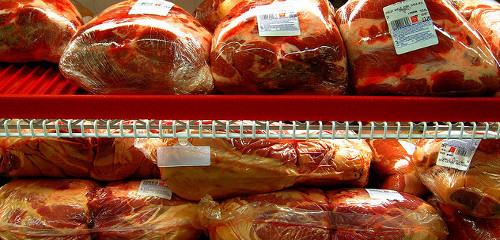
Soaring demand for meat across the world has caused a major uptick in the amount of antimicrobial drugs in pork, beef and poultry, according to a new study published in the journal Proceedings of the National Academy of Sciences.
But the the worst offender, by far, is pork: with the increasing global popularity of bacon and a booming pork market in China, pig farmers around the world are meeting demand by using about four times as much antibiotics per pound of meat as cattle ranchers. Poultry is a close second.
The antibiotics serve two purposes. First, they help fatten up livestock at a faster rate, allowing farmers to produce more meat in a shorter amount of time. Second, they keep animals healthy despite being raised in overcrowded, filthy conditions where disease spreads easily.
In 2010, the world used about 63,000 tons of antibiotics to raise cows, chickens and pigs, the study estimated. That’s roughly twice as much as the antibiotics prescribed by doctors globally to fight infections in people.

This charts shows that pigs, for the most part, consume the highest density and amount of antibiotics. (Image Credit: PNAS)
With half of the world’s pigs living in China, the country tops the list as the biggest antibiotic consumer in farming. But the U.S. isn’t far behind in second place, using about 10 percent of the world’s total. Brazil, India and Germany round out the top five for farm animal consumption of antibiotics.
By 2030, the researchers expect antibiotic use to rise to more than 105,000 tons annually, as countries like China see an increase in wealthier households who are able to consistently afford meat. As they explain in the study:
We project that antimicrobial consumption will rise by 67 percent by 2030, and nearly double in Brazil, Russia, India, China, and South Africa. This rise is likely to be driven by the growth in consumer demand for livestock products in middle-income countries and a shift to large-scale farms where antimicrobials are used routinely. Our findings call for initiatives to preserve antibiotic effectiveness while simultaneously ensuring food security in low- and lower-middle-income countries.

Regions that produce the most pork and chicken also use the most antibiotics on farms. Hot spots around the world include the Midwest in the U.S., southern Brazil, and China’s Sichuan province. Yellow indicates low levels of drug use in livestock; orange and light red are moderate levels; and dark red is high levels. (Image Credit: PNAS).
Consumption of antibiotic-fed meat poses a major threat to humanity. If a group of animals is treated with a certain antibiotic over time, the bacteria living in those animals will become resistant to that drug. Exposure to human antibiotics through meat has given rise to antibiotic-resistant “superbugs,” which a recent study predicted could kill up to 10 million people worldwide by 2050 if left unchecked.
As awareness of this threat grows, some companies have removed antibiotics from their meat supply. Earlier this month, McDonald’s vowed to remove human antibiotics from its chicken supply, though animal antibiotics would continue to be used and the human drugs would remain in beef and pork products. Chick-fil-A pledged to remove all antibiotics from its chicken last year, while Chipotle, Panera, Shake Shack, and Whole Foods already buy all antibiotic-free meat.
Still, the industry seems unlikely to change unless more consumers demand antibiotic-free meat. Only the European Union has been successful in banning the use of such antibiotics and hormones. In the United States, legislation has done little to stymie the growth of the use of antibiotics, and insiders say lawmakers are unlikely to act, primarily because of the meat industry’s aggressive lobbying tactics and deep pockets. Meanwhile, in China, no such legislation exists.
